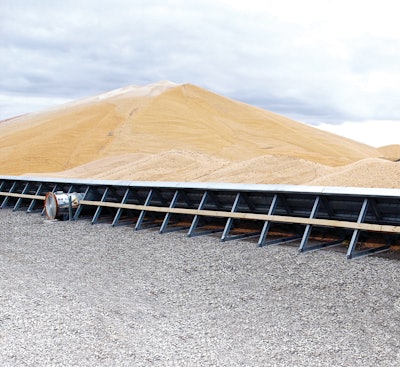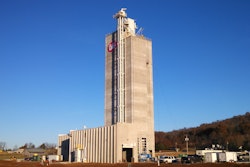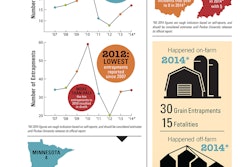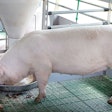
2014年9月11日当它发布了作物报告,the U.S. Department of Agriculture predicted record national yields for both corn and soybeans. With many farmers still holding on to last year’s crop in hopes of higher prices, and a backlog in rail shipments causing at least one elevator to close its doors, are the nation’s grain elevators ready to absorb the tsunami of grain poised to crash down? What about next year’s crop?
What temporary storage can do
Temporary storage may be the solution to handle the harvest overflow for years to come. Relative to conventional storage, e.g., bins or silos, temporary storage options both cost less and take much less time to put up. They can be used for decades, but are only meant to hold grain for a short time. This window means that elevators will not have to turn away grain, and can take the time to find the best markets for their product.
“The word temporary often gets mixed up,” explains Mike Johnson, marketing at GSI Group. “The word temporary stands for how long you’re going to store the grain in the pile. We target getting the grain in the pile around 14% moisture, and unloading it around a March-April time frame with May being the latest.”
When used properly they can keep spoilage to a minimum — anywhere from 5% to 0% spoilage — but only during the colder months of the year.
“Temporary storage is great if there is suddenly a bigger harvest than a facility was expecting, and it needs a better way to store grain than just dumping it on the ground, and a guaranteed 10% loss,” explains Shad Singleton, sales, at Union Iron. “If everything is done right, there can actually be as little as a 0% loss.”
A quick solution
While it is always the best practice to plan any expansion well ahead of time, it isn’t regularly a luxury that Mother Nature allows. If an unexpectedly large harvest looks likely to occur in your area, many temporary storage projects can go from start to finish anywhere between five months to 10 days.
“An oval system with the right contractor can take between 10 to 14 days,” says Johnson. “With a round system, three weeks would be fast while six weeks would be ideal. People and time are the driving factor.”
Ten days may be possible, but many different factors can affect the project time.
- The size of the storage unit
- What type of temporary storage being put in
- Features desired
- How busy the manufacturer is
- Weather
“Make sure to give yourself plenty of time,” cautions Larry Stayner, inside sales at LeMar Industries. “Something comes up and these things always take longer than you think.”
Companies will be able to give a firm estimate on the time frame after they help a grain handler determine exactly what they need.
“When called out to a site, we will help determine what a facility needs to accomplish what it set out to do,” Stayner explains. “We use programs to help us find the optimal way to use the space, and to eliminate waste and spoilage.”
Oval
When grain elevators need storage and need it quickly, they turn to the oval design. This type of temporary storage has been the industry standard for years for a reason — it is faster to build, movable and expandable. Created by placing prefabricated walls along the ground, with the ends being rounded and the sides being straight, these structures can be as long as the buyer wishes.
“If a facility builds an oval pile that’s 500 feet long, and down the line decides it needs a pile 1,000 feet long, it can just add to what you have,” Singleton says. “Simply remove the end and take off running.”This type of structure is loaded manually, by having trucks unload the grain or with a portable conveying solution. It also holds less grain per devoted area than a center fill system and has fewer available options compared to a ridged tension structure, but it’s the only system that can be installed in weeks rather than months.
Center fill
If more time is available, a center fill storage solution can become a permanent addition to a facility. A center fill design uses an elevator leg to move grain from the main facility into the middle of the circular area. This leg can be a temporary or permanent addition.
The grain expands from the center tower until it reaches the top of the perimeter wall. The height of the tower is the limit of a center fill temporary storage system, but it can fit a larger amount of commodity in a smaller space. The center fill design is also harder to install and has more components. While it can be put up in as little as a month if conditions are right, expect a longer wait.
Rigid tension structure
介于两者之间一个椭圆或中心填补设计lies what Legacy Building Solutions calls a rigid tension structure. Named for their rigid frame, these structures combine a steel frame with fabric construction; each one is custom made. Rigid frame tension fabric buildings are easily adaptable for permanent or temporary grain storage, plus other agricultural uses.
“We’ve gone away from the hollow tube frame system and are using the same rigid frame technology that has been used in steel buildings for decades,” explained Paul Smith, a sales and project design representative for Legacy Building Solutions. “We’ve continually upgraded our fabric building until it became something never quite available before.”
While both oval and center filled storage facilities are set up with aeration and conveying in mind, rigid tension structures can support aeration systems, conveying equipment and catwalks from their solid metal frame. These added benefits come with a cost; rigid frame buildings may be more expensive than other temporary storage options available.
“We kind of fall in the middle,” says Smith. “Traditional fabric hoop buildings will be on the cheaper end, but a facility may have to replace covers after nine to 10 years. Steel bins are more expensive, but after 20 years they often need repairs — our structures are warrantied for 20 years.”
Faster to erect than steel bins, tension fabric buildings will take more time to build than oval or center fill structures. Concrete is ideally poured on-site, with contract-to-completion times typically averaging between seven and 11 weeks.
When producers are bringing in a record harvest, time might be the most valuable factor in deciding what type of temporary storage to choose.
Company Profiles

Union Iron
• 4-, 6- or 9-foot all-perforated heavy-duty 14-gauge plank sidewalls
• Center grain tower with doors and tarp winching system available
• Air is pulled through our perforated
sidewalls and is exhausted through very rugged AIRLANCO fans
• Able to be installed on uneven surfaces, requiring minimal site preparation
• Can be set up in almost any open space
For more information call 800-333-5148 or email[email protected].

GSI
• Effective and cost-efficient
• Options range from center tower loading systems to oval piles
• Galvanized steel components and 4-, 7- or 10-foot louvered wall panels for long product life
• GSI’s patent pending aeration system is customized and provides the maximum airflow
For more information call 888-GSI-BINS or email[email protected].

Legacy Building Solutions
• Combining the strength and versatility of structural steel with the proven benefits of a fabric membrane
• Customized structures built to requirements
• Can support cranes, catwalks and conveyors for convenient use
• Can be engineered to receive product by rail or truck
• Fabric roof has excellent life expectancy
For more information call 877-259-1528 or email[email protected].


.jpg?auto=format%2Ccompress&crop=faces&fit=crop&h=48&q=70&w=48)




















